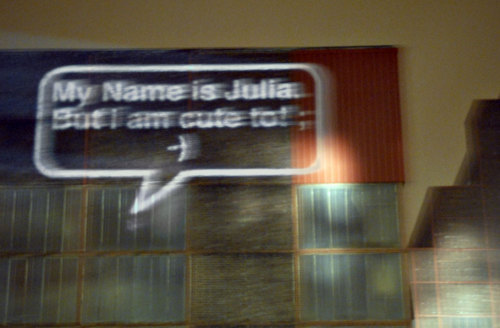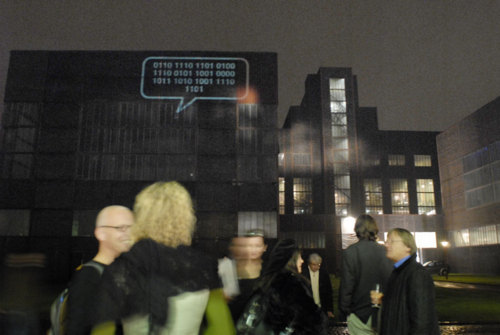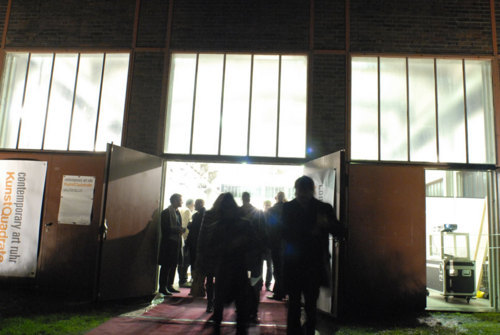
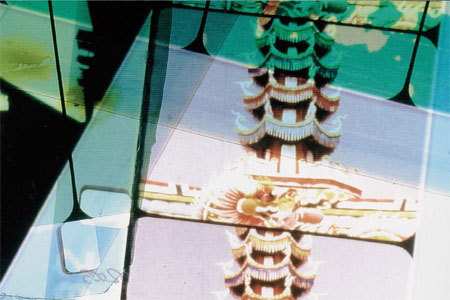
Deborah Phillips, 24th of July, Scala
A characteristic of Deborah Phillips’s work is a conscious experimentation with colour and the emphasis on fleeting, collage-like, overlapping impressions by means of multiple exposures and fading. She lives and works in Berlin.
program starts at 9pm, doors open 8pm
See you at the Scala, Friedrich Str. 112 A, 1st floor
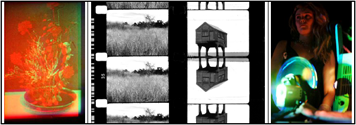
thurs. 26th of june at the Scala
Sally Golding (Brisbane) is a filmmaker, projectionist and audio-visual archivist whose work moves between materialist abstractions and dreamlike narrative forms. Using 16mm technologies and photographic darkroom processes, Sally deconstructs cinematic materials and apparatus, creating unique works realised as performed projection.
Afterwards live music from Mexico
program starts at 9pm, doors open 8pm
See you at the Scala, Friedrich Str. 112 A, 1st floor
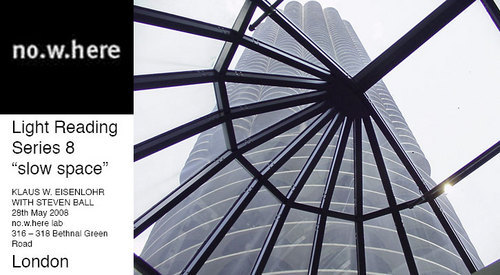
28th may 2008
klaus w. eisenlohr with steven ball
showing: slow space
Light Reading’s 2008 series continues with a conversation between artists Klaus W. Eisenlohr and Steven Ball. Eisenlohr’s film Slow Space (2004) will be screened during the event.
Klaus W. Eisenlohr is an artist, photographer and filmmaker living in Berlin. He is currently curator of “Urban Research”, an ongoing film and video project concerned with urban development and public space, at Director’s Lounge, Berlin. Eisenlohr’s recent work can be characterised as “camera-guided” rigorous research into exploring the body within the spaces it inhabits, and aiming to go beyond mere representation of public spaces through film, but to encourage a perception of space that goes beyond the camera’s frame.
Slow Space (2004) is a film journey through buildings of glass architecture in Chicago. Street scenes and interviews complement this essay on public and private spaces.
Slow Space takes the viewer on a visual trip through the city of Chicago without showing streets or plazas as they are seen in travel guides. Instead, the journey goes through places roofed and lit by glass architecture: Garfield Park Conservatory, Juvenile Court, Merchandise Mart, Cumberland Station, Nature Museum, Westside Future, César Chavez Elementary School, Tower Condominium, Jackson Academy, Lincoln Park Conservatory, a private living room, Gran Hyatt Regency and some other places. Scenes set in open urban space and interviews filmed in private homes complement this passage through public and private places. The project investigates the relationship between the body and the urban architectural environment over a period of three years. Searching the anomalies in “normal”, the filmmaker traces a ‘Desire for Modernity’ in the city’s architecture being shaped by pre- and post- modern forces. In addition, the film discusses the topic of public space in American cities through interviews with the Chicago artists and filmmakers Deborah Stratman, Chris Harris, Gretchen Till, Ken Fandell, Thomas Comerford and Eduardo Pradilla.
Eisenlohr’s work has been shown internationally, with recent solo and group exhibitions at the Alten Wiehre Banhof, Freiburg, Germany, 2007, Inner Spaces Gallery, Poznan, Poland, 2007 and at the Helsinki International Artist-in-residence project room, Helsinki, Finland, 2006.
Steven Ball is a time based media artist. His recent work has focused predominantly on working with digital video producing a series of works that are, among other things, particularly concerned with digital material processes and spatial representation. He is currently Research Fellow at the British Artists’ Film and Video Study Collection, Central Saint Martins College of Art and Design, London.
Light Reading is an ongoing series of critical dialogues that engage artists, writers and curators in conversation around a selected artist’s body of work.
slow space: film info
www.steven-ball.net
Direct Objective – Blog
no.w.here lab
More Milk Yvette – Blog
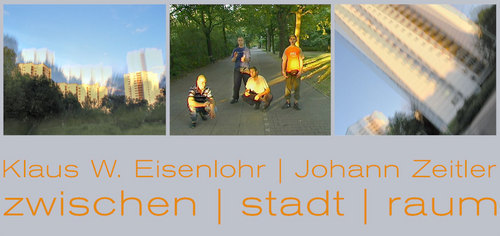
statements from gropiusstadt berlin
3-channel video installation
Premiere of the video
by Klaus W. Eisenlohr and Johann Zeitler
Saturday, 1 March 2008 at 16:00
In 2006 Klaus W. Eisenlohr and Johann Zeitler worked as artists-in-residency at “Pilotproject Gropiusstadt”. Using the camera as a means for interaction, they met with people from Gropiusstadt, a large scale-residential housing project from the 70’s in Berlin. They talked with people who are active in the public realm or, who just use public in their daily life. From the large amount of video recordings and photographic images they took, the two artists have edited a three-channel video composition. It shows impressions and statements about Gropiusstadt and about the conditions of public space in this modernist part of the Berlin city.
The art works’ theme focuses on perceptions: the perceptions made by inhabitants, by local citizens, but also the perceptions conceived by the artists. In their work, the artists ask about the constructions and the representations of urban space. When does public space exist? How do people see, reflect on and use public space? How have architecture and the social constructions of modernist public space influenced daily life, senses and human bodies? Which kind of interventions would have a positive impact on common perceptions?
“In this video work, the people of Gropiusstadt are given a voice: inhabitants from divers backgrounds talk critically, but also positively, about their surrounding and they show their bonds to the quarter they live in. These reflections are being complemented with the perceptions of the artists who came from outside, and who have been looking at Gropiusstadt with fresh eyes and with little preconceptions.”
“They walked around in parks, the green axis called Wildmeisterdamm, in the streets and the green zones. They met many people and asked them: ‘How do you perceive the public space in Gropiusstadt? Do you like the design of the green zones? How did the area change since you moved in? Where do you feel safe, and where insecure?’ And they asked youths, when they met in the street: ‘What are your activities when being outdoors? Do you have specific meeting points? Do you have special places you feel like they are yours? Where do you ‘hang out’? Where are things happening?” (Walter 02/078, Gropiusstadt Magazine)
These statements about the past, the changes and the present state of Gropiusstadt may be an inspiration for a rethinking of the much despised modernist city planning concepts, for a renewed discussion of the ideas of city planer Walter Gropius, and of public housing projects. In the video zwischen | stadt | raum, as a result, Gropiusstadt — one of the modernist icons of post-war Berlin — appears to be a divers area, with ambiguities, alive, and worth to be lived in.
Gemeinschaftshaus Gropiusstadt, Kleiner Saal
Bat-Yam-Platz 1
12353 Berlin
U-Bahn: Lipschitzallee (U 7)
Premiere of the video
zwischen | stadt | raum
by Klaus W. Eisenlohr and Johann Zeitler
Saturday, 1 March 2008 at 16:00
Opening
With Diskussion:
Public Space, Gropiusstadt, and the Future of a Suburb
Saturday, 1 March 2008 at 21:00
Gropiusstadt Songs
Rap with groups from Gropiusstadt
Sunday, 2.3.2008 um 16:00
Gropiusstadt as a meeting place
Coffee, Discussion and Cake
With Frauencafe, ImPULS, Seniorengruppe and others.
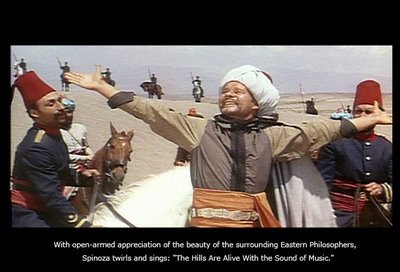
Happy Famous Artists : eastern philosophy in berlin
Happy Famous Artists are a collective combining ideas of Intelligensius Anarchus and Jeff Blind.
“ Our work is multimedial and conceptual with main areas of inspiration being the sciences, philosophy and psychology, political and social phenomena on one side, and classical as well as contemporary art and popular culture on the other. Our key interest lies in the research of how these perceived authorities shape and influence general perception of reality.”
Eastern Philosophy, the logical sequel to Western Philosophy, will be presented in world premiere in attendance of the Happy Famous Artists
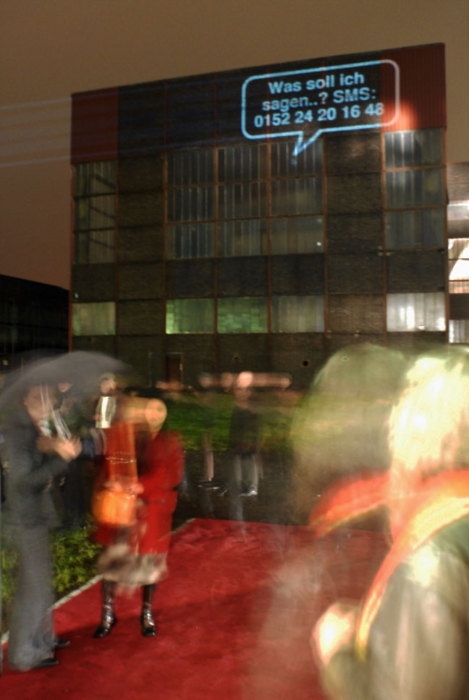
TXTual healing, an SMS Enabled Interactive Video Performance by Paul Notzold as part of the opening of KunstQuadrate, contemporary art ruhr.
